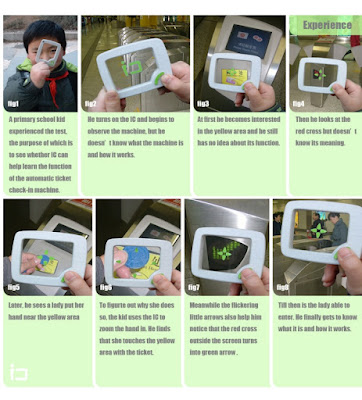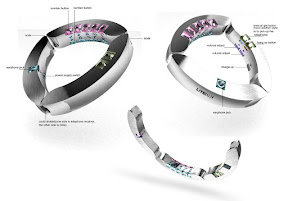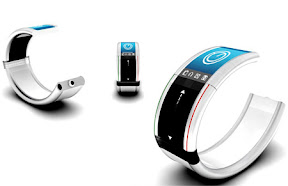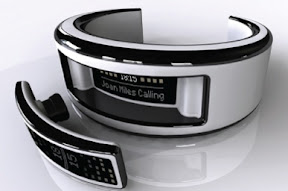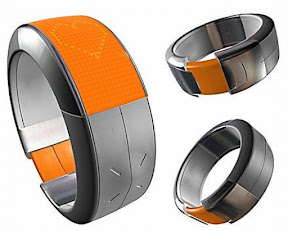Mobile communications for children. A worry point for parents - babies are to be in touch. A sweet piece for mobile operators and phone manufacturers - children are not fully captured by the business and can consume more traffic. So - the classic design exercise: mobile phone for children. It must be:
- Suitable for users (very young people): simple, pretty, light, tough and safe;
- Suitable for owners (very nervous parents): controlled, reliable and cheap.
The common root for all these properties is: being simple.
So - the small rounded rectangle with a single button: "Call". The idea of such a minimalistic one- or two-button communication Device is not new. Moreover it is actively exploited, especially as an emergency device - you press the button and the phone will connect you to the call-center. The proposed idea core is to adapt the Device class to the specific use.
-
Shape and size. There are two size limitations: length (for the antenna to work) and volume (for the battery to store energy). Device length can be 8 cm (wavelength quarter) or even smaller for 900 MHz GSM - quite compact. Battery feeds just a transmitter - there are no bright displays or powerful CPUs, so its capacity (and volume) could be small. I suppose a small rounded brick would be the best shape - it can be pleasant, easy to personalize (important for youngs) and simple to manufacture. The Device housing should be cast solid - no holes, sockets or detachable parts. Thus enough durability, water-, dust- and dirt-proofness will be achieved. So even the battery can have no packaging therefore saving weight and manufacturing cost. To avoid SIM-card manipulations the SIM chip have to be integrated into the Device. The speaker and the microphone should use a surface membrane, thus eliminating garbage collecting holes.
-
Controls. A button "Call the parent" - call a programmed number. The same button is used to hang up. Slightly advanced model can have several call buttons - for a specific number each. If the programmed number calls, the appropriate button will blink. For a rectangle case the best button shape is rectangle too. Ordered in a single column along the main axis of the Device face.
-
Power supply (charger). No sockets. A short-length wireless inductive power transmission should be used (a split electric transformer). Field shape design, relatively low frequency and device sensor make this approach safe enough. Also this EM link acts as a communication medium (see below). It should be a "base station" to drop the Device for charging.
-
Communication. Again - no sockets. The primary medium to control and program the Device is a contact-less base station. It is wired to the mains for power, optionally - to a computer. And - to a parent mobile phone via Bluetooth to program and control.
-
Programming. To assign a phone number to a button and to free a button. To accept or reject unidentified calls. The simplest way ("call me") is:
A parent dials the device number -
- The Device detects the calling number and rings, all free buttons blink -
- Press a blinking button; the calling number will be assigned to the button.
More complex approach is an (Java) application for a parent mobile phone. The application connects the Device base station via Bluetooth and later - the Device itself via an proprietary power link protocol (see Power supply). The application uses an unique security code (such as SIM PIN code) to access the Device.
In the last case the Device is programmed by the mobile network operator remotely. A parent uses the operator web interface to request a programming task and the operator does the job via SMS or so.
-
Personalization. The Device has a simple and solid shape with flat sides. This makes it suitable to be decorated. The membrane "call" buttons could be signed by a pen and a thick soft transparent rectangle (provided with the Device) could be glued over to make a customized button.
-
Service.
The device have to be locked to a mobile network operator. Sure the operator will offer dedicated group tariffs for parents and children with the Devices. The Device can guess its location using network cell data (to avoid an extra GPS receiver). And the Device should track is it with the child or not (using location tags or a simple electric capacitance measurement). Parents are informed about this by SMS or by an operator location service and a Java application for a parent's phone.
Safety. The device is deeply personalized. A stealth biometric authentication (such as one being developed by Apple) pushes the personalization even more. Also the Device is so cheap that there are no reason to steal it or even to robber. So it is safer for children. Simplicity and tough construction make the Device not breakable. So accidental injury risk is less.
Network operator side. Because there isn't a SIM-card, the Devices are sold with a pre-programmed phone number. Because of the users nature, the Devices will be lost frequently. Thus many phone numbers are wasted. But these numbers can be reused fast - only the parents know the actual Device phone number so no one will call the lost Device.
The Device should observe some of common earlier proposed location tags: classroom, gym, theater, etc. So there won't be loud rings in a class.
The Device could be good and simple for parents. I.e. for money payers. I.e. could be sold in tons even in drug-stores.
